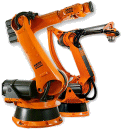What is the definition of a 'robot'?
Robot
comes from the Czech word robota,
meaning drudgery or slave-like labor.
"A
reprogrammable, multifunctional manipulator designed to move material, parts,
tools, or specialized devices through various programmed motions for the
performance of a variety of tasks"
Why Use
Robots?
Most robots are designed to
be a helping hand. They help people with tasks that would be difficult, unsafe, or boring for a human to do.
Specific
Robotic Tasks In Manufacturing
- Assembling products
- Handling dangerous materials
- Spraying finishes
- Inspecting parts, produce, and livestock
- Cutting and polishing
- Welding
Types
- Cartesian robot / Gantry robot: Used for pick and place work, application of sealant, assembly operations, handling machine tools and arc welding. It's a robot whose arm has three prismatic joints, whose axes are coincident with a Cartesian coordinator.
- Cylindrical robot: Used for assembly operations, handling at machine tools, spot welding, and handling at diecasting machines. It's a robot whose axes form a cylindrical coordinate system.
- Spherical robot / Polar robot (such as the Unimate): Used for handling at machine tools, spot welding, diecasting, fettling machines, gas welding and arc welding. It's a robot whose axes form a polar coordinate system.
- SCARA robot: Used for pick and place work, application of sealant, assembly operations and handling machine tools. It's a robot which has two parallel rotary joints to provide compliance in a plane.
- Articulated robot: Used for assembly operations, diecasting, fettling machines, gas welding, arc welding and spray painting. It's a robot whose arm has at least three rotary joints.
- Parallel robot: One use is a mobile platform handling cockpit flight simulators. It's a robot whose arms have concurrent prismatic or rotary joints.
- Anthropomorphic robot: Similar to the robotic hand Luke Skywalker receives at the end of The Empire Strikes Back. It is shaped in a way that resembles a human hand, i.e. with independent fingers and thumbs.
.jpg)


No comments:
Post a Comment